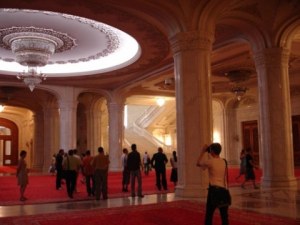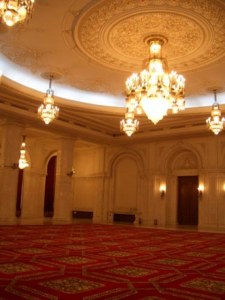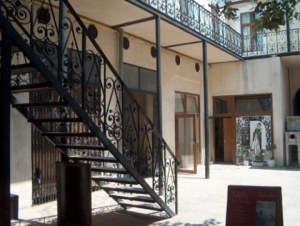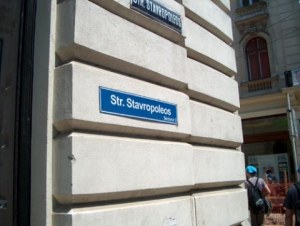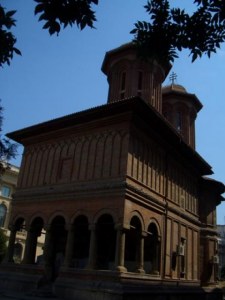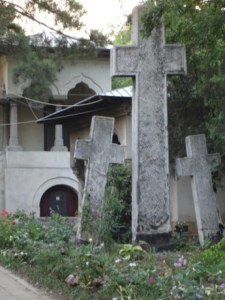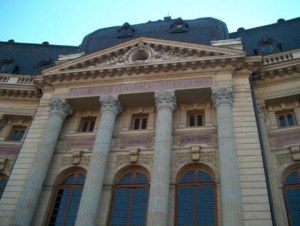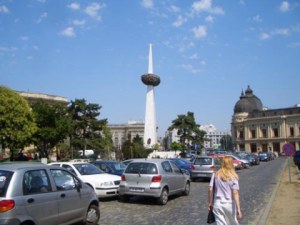We stayed in Bucharest for a total of 3-4 days. This is more than enough to visit the basic sightseeing of the city, especially in periods with no traffic jam like summer holidays period. Bucharest is relatively easy in the orientation. Anyway, best maps someone can use, not only for the city but for the entire country are the ones from Cartografica publications. They are available in almost the majority of petrol stations. Sunday afternoon (08-07-2007) Vangelis joined us. He came from Italy via Slovenia and Hungary in order to continue his summer vacation with us. He was travelling with Ploutonas and my brother Nikos in Austria, Italy and Slovenia before...
Here is the basic sightseeing that we visited at the duration of our stay in the capital:
Parliamentul : It is the best known building of capital. Romanians call it Casa Popurului (the house of people). It is the 2nd bigger building in facade of the world and 3rd in size. His manufacture began while Nicolae Ceausescu was ruling over. 1/6 of the surface of Bucharest had to be demolished and 20.000 workers had to be alert in 3 possessed shifts in order to materialised this plan. It is said that the same volume which visible externally exists also under the surface of the ground. Up to the present day works are not totally completed. Now it is used to accommodate certain government services. You can visit part of the building following a guided tour (tickets of 9Ron per person). The long avenue extended in front of Parliamentul, bulevardul Unirii, is a few metres longer than Elysian Fields in Paris. Nicolae Ceausescu was so megalomaniac that he desired to construct a monumental city according to Parisian standard and even better. In the middle of bulevardul Unirii is found the central square of city, the square Unirii.
Square Unirii : This central square is well-known for the impressive fountains and for the oldest commercial centre. In fact the later has been upgraded in large extent due to renovations. Along the central square monumental buildings of Ceausescu’s era stand that were used as residence for executives of party. It is reported that a hole church was entirely transferred for certain metres because it was situated in a point that prevented the construction of a building! Behind those buildings there are arias not visible from the square where you can still find small old houses that are rescued from the demolition. An artificial river called Dimbovita crosses Piata Unirii. Ceausescu’s belief was that no city is considered as European capital without a river. Thus he ordered the construction of Dimbovita whose bed is also used as sewerage.
Lipsicani : Lipscani is the old part of the city which is situated northern of Unirii square. There are efforts lately to maintain the character, renovate the buildings and reconstruct the paved with slabs. The atmosphere has changed enough from the last time I found myself in the region. Back then it seemed abandoned and disreputable. Wandering in the allays we found easily the greek named street Stavropoleos. There you can visit an interesting old church with byzantine hagiographies. I believe that when the works will be completed this part of Bucharest will be one of the most interesting places to visit in Europe.
Patriarhiul Romaniei : In the southern side of square Unirii at the end of acclivitous street is found the Rumanian Patriarchate. It is constituted by a small group of classic buildings and a Byzantine church with lots of hagiographies in its interior but also in its facade. The interesting part of the frescos is the depiction of Crisis, depiction that we met in a lot of monasteries of region Bucovina (in the north of the country).
Centre : Leaving the Unirii square and moving towards the north, by following the central streets of Bratianu, Magheru and Balcescu, we reached the commercial centre of city. We passed by Universitate and Romana square, where you can find the Economic University. Today those places are full of shops cafeterias and restaurants which didn't existed 5 years ago. Finally we reached the square of Revolution, name it gained after the incidents of 1989. Apart the Ateneum, building with amazing architecture, you can find the majority of the monuments concerning the revolution. A couple of years ago the monument for the victims of revolution was manufactured. An enormously iron plate is reporting their names. This monument has a symbolic character. A strange and very noticeable building whose ground floor is of old classic architecture and the rest is of new glass architecture. Before 1989 there was accommodated the heart of the secret services of the country, the well-known Securitate. After the revolution, people’s mania demolished the first floor and placed a glass green tower while the ground floor was left as before. In this way in means of architecture is expressed the rupture with the past...
Park Cismigiu : Park Cismigiu is situated western of the square of Revolution. Full of green, it provides the residents of the city with moments of resting and relaxation. We visited this park in order to avoid the heat of the summer days in Bucharest. In the centre of the park stands an artificial lake while on the peripheral zone you can enjoy a cup of coffee or a meal in the cafeterias and restaurants. In the southern side of the park is situated the town hall of city. We followed the street that passes from its front (str. Kongalniceanu). And then in order to visit Cotriceni region we passed in front of the medical and the low school.
Cotroceni : In this region stands the palace where the chairmen of state live (equivalent with the Palace Maximou in Athens). Tourists can enter, but it needs to declare your name at least 2 days before in order to get the visiting permeation. We didn't have that time.
Parcul Herastru : During our stay in Bucharest we visited the region of Herastru and the homonymic park. It is in the north of the centre and you can reach it following the direction to the airport, the Aviatorilor Avenue precisely. Herestrau region is one of the richest regions in the capital where the majority of the embassies and central buildings of political Rumanian parties are pleced. Herastru Park has a big artificial lake in the middle of which is an island. Many people go sailing, swimming and several other sports. You can find cafes and several restaurants on its shores. South-west the lake is found the Museu Satului (Museum of the Village) that is impressive and worth a visit.
Arcul de Triumf : Moving westwards the Museu Satului, we found ourselves in front of the imposing Arch of Triumph (Arcul de Triumf). You might have a sensation for a moment that you are in Paris, but the flag that is found on its top proves that you are in Romania. During Ceausescu’s era, Bucharest was considered as "Small Paris".
Piata Presei : The square took the name after the imposing building. Romanian television and radio were accommodated there. It is said that from this building citizens were spied on.
Bucharest has many significant sightseeing, remarkable museums and interesting political history. You can find many details in travel guides.
As far as it concerns food, we would definitely suggest La Mama Restaurants ( www.lamama.ro ). One can taste the best traditional recipes in good prices there. La Mama Restaurants are found in several central points of the city. We chose the one found on Episcopiei 9 str., near Piata Revolutiei. Don't skip the delicious traditional soups (Ciorba). They are served in various flavours. If again you wish eastern flavours, I would propose ABU-ABDU Lebanese restaurant that is found in Piata Muntii. It is rather economic with tasteful receipies and while my student ages this was my frequent choice. Fast foods are relatevly expensive in Bucharest. Greek franchise "Everest" and "Gregory's" are found everywhere. As far as it concerns entertainment Bucharest has a night life. Several pubs are located in the centre between Romain, Revoluiei and Universitate squares and in the old city of Lipsicani. If you prefer clubbing, go to the region Herastru and near the Lacul Tei where many fancy clubs are located. For the funs of greek commercial music there is Bouzoukia "Elysse" (blvd. General Magheru), a certain revival of the 80’s decade.
Other general information: Bucharest and the coastal region of Costanta are roughly 2 or 3 times more expensive than the rest of the country.






